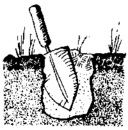- Cathole
-
A cathole or cat hole[1] is a pit for human feces. Catholes are frequently used for the purpose of disposing of bowel movements by hikers and others engaging in outdoor recreation.
Catholes must be located at a reasonable distance (at least 60 m) from water sources (rivers, lakes, etc.), to avoid possible bacterial contamination of water via precipitation, as well as away from trails. For faster feces decomposition, organic soil is preferred over a mineral (sandy) one. It is also recommended to avoid concentration of catholes around campsites. Filled catholes must be covered with a reasonably thick layer of soil, to prevent access by animals, some of which are coprophagous.
In some areas, it is not appropriate to dispose of human feces through the use of catholes. For example some areas require special instructions on human waste disposal. In rocky places, with the absence of soil, it is advised to smear feces thinly over rocks that have good sun access for faster sterilization by UV radiation and drying. In larger snow fields, a larger distance (e.g., 200 m) from trails and campsites may be mandated, if the waste is being disposed under snow.
See also
References
- Sanitation - instructions from Olympic National Park.

This health-related article is a stub. You can help Wikipedia by expanding it. This article about outdoor recreation is a stub. You can help Wikipedia by expanding it.

